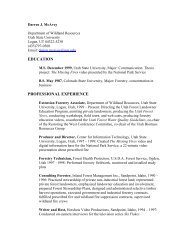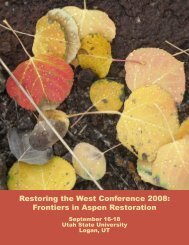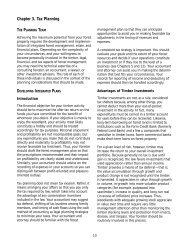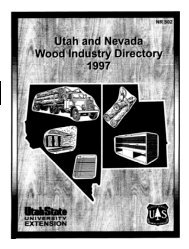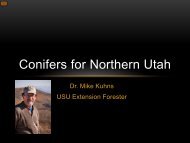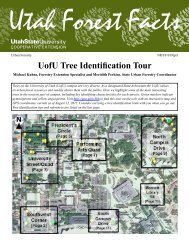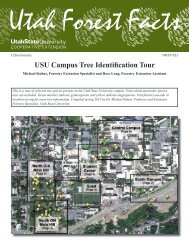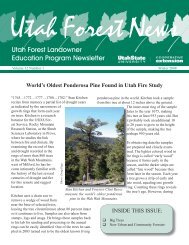A Technical Manual for Landowners, Loggers, and ... - Forestry
A Technical Manual for Landowners, Loggers, and ... - Forestry
A Technical Manual for Landowners, Loggers, and ... - Forestry
Create successful ePaper yourself
Turn your PDF publications into a flip-book with our unique Google optimized e-Paper software.
R O A D S, S K I D T R A I L S , L A N D I NG S & S T R E A M C R O S S I NG S<br />
R O A D S, S K I D T R A I LS , L A N D I NG S<br />
& S T R E A M C R O S S I NG S<br />
■ Firmly pack material around culverts, especially around the bottom half,<br />
to anchor them <strong>and</strong> prevent washing out.<br />
■ Where it is not possible to install culverts at the gradient of original<br />
slope the outlet should be armored with rocks, logs, or other materials to<br />
dissipate the energy of the falling water. (See figure 4.12)<br />
■ Place rip-rap around the culvert inlet to prevent erosion due to turbulent<br />
water flow. Rip-rap is most effective when placed on top of geo-textile<br />
material. Geo-textile is a fabric mat that allows water to drain through it<br />
while supporting materials above.<br />
■ Use adequately sized culverts <strong>for</strong> stream <strong>and</strong> runoff flow. Anticipate<br />
storm peak flows <strong>and</strong> size culverts accordingly (see Table 4.4).<br />
■ S t ream gradients should not be changed when installing culverts. To function<br />
pro p e r l y, culverts should be aligned with the natural stream channel.<br />
■ Install culverts with the same slope of the natural stream bed. A pitch of<br />
2-3 percent will cause the culvert to be self-cleaning.<br />
■ P rotect fill <strong>and</strong> culvert by armoring the inlet <strong>and</strong> outlet ends of the culvert .<br />
■ Inspect culverts regularly <strong>and</strong> clean as necessary.<br />
Figure 4.12<br />
Properly installed culverts result in no change in the stream bed.<br />
Installation of Culvert<br />
Road Surface<br />
Level of natural<br />
streambed<br />
Road Surface<br />
1' Minimum<br />
Culvert<br />
Rock Free Culvert Bed<br />
(gravel or soil)<br />
2<br />
slope<br />
1<br />
Mulch<br />
At least 1' of cover<br />
or 1/3 of diameter <strong>for</strong><br />
larger culverts<br />
Base <strong>and</strong> sidewall<br />
fill material should<br />
be compacted<br />
Tamp backfill material<br />
at regular levels<br />
Rock armoring <strong>and</strong> riprap should be<br />
used to protect both ends of the culvert.<br />
A permit may be required <strong>for</strong> construction activities affecting the bed or banks of<br />
a stream. This includes the placement of stream crossings.<br />
For more in<strong>for</strong>mation, contact the Utah Division of Water Rights at<br />
P.O. Box 146300<br />
Salt Lake City, Utah 84114-6300<br />
801.538.7375<br />
Use of geotextile fabric.<br />
Adapted from The Bureau of <strong>Forestry</strong>, Wisconsin Department of Natural Resources<br />
30 page page 31<br />
Geortextile<br />
filter fabric



